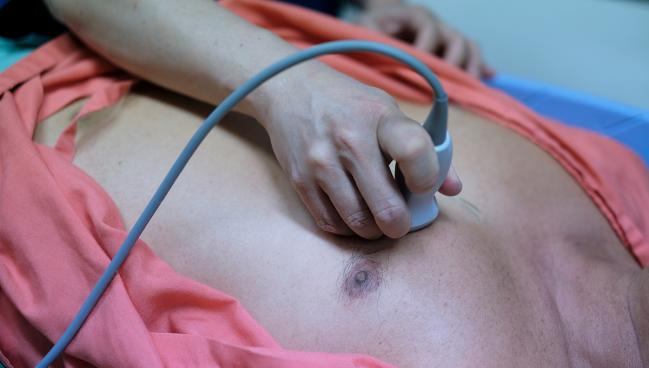Undiagnosed Valvular Heart Disease Prevalent in Older Adults
The number needed to screen was just 15, authors say, making a case for routine echocardiography in adults older than 75.

Almost one-third of people over the age of 60 have valvular heart disease, although less than 3% have clinically significant disease, according to new registry data from the United Kingdom. The authors argue their findings support the need for a universal screening program in the elderly to identify and treat disease before it becomes dangerous.
Previous research has demonstrated that elderly patients with aortic stenosis tend to present late in their disease course, having ignored symptoms or attributing them simply to old age. This often worsens their prognosis, potentially leaving them beyond the reach of treatments.
“The first thing that we hope this study would achieve is to put it out there that valvular heart disease is not uncommon,” senior author Vassilios S. Vassiliou, MBBS, PhD (Norwich Medical School, University of East Anglia, England), told TCTMD. “It's not uncommon at all. And therefore, if individuals have symptoms that are consistent with valve disease, they [and] family physicians should consider that as opposed to putting it down to just old age.”
Secondly, he added, “we're hoping this study will start a conversation about screening. At which stage will screening for valvular heart disease be suitable? This is a very complex area, because it depends on the type of healthcare system in which people are working and it depends a lot on how much echocardiography and ultrasound of the heart cost.”
Commenting on the findings, Sreekanth Vemulapalli, MD (Duke University School of Medicine, Durham, NC), told TCTMD they confirm on a larger scale what was seen in the OxVALVE-PCS study, in which 51% of 2,500 UK-based individuals aged at least 65 years had any undiagnosed valvular heart disease, including 6.4% with clinically significant disease. The main strengths with the current study are that it recruited patients from multiple locations and outside of the traditional clinical setting, he said.
Together, these studies reinforce the need for greater awareness among both patients and physicians alike of how prevalent valvular heart disease actually is among elderly people, according to Vemulapalli. “If you're a member of the public and you're experiencing shortness of breath, swelling, or chest discomfort—any of these things which might be coming from valve disease—you should be telling your doctor, ‘Hey, I'm having these symptoms and one of the possibilities may be valve disease,’” he said. “On the other side for providers, they need to know that there's substantial prevalence of this disease amongst their older population.”
Many practitioners don’t routinely use their stethoscopes to auscultate patients, Vemulapalli pointed out. “You can't possibly pick up valve disease without that, and they're not necessarily thinking about it,” he said. “These kinds of studies should serve to say: ‘This is out there and you need to keep it in mind.’”
A Quarter With Unknown Disease
For the study, Vasiliki Tsampasian, MSc (Norwich Medical School, University of East Anglia), Vassiliou, and colleagues invited more than 10,000 seemingly healthy adults aged ≥ 60 years in the United Kingdom between 2007 and 2016. In total, 5,429 volunteered to answer a health questionnaire and undergo a clinical examination and transthoracic echocardiography, and 4,237 (mean age 69.1 years; 52.2% female; 97.7% white) were eligible to be included in the study population.
More than one-quarter of individuals (28.2%) had some sort of valvular heart disease, with 13.8%, 12.8%, and 8.3% of disease affecting the tricuspid, mitral, and aortic valve, respectively. The rate of clinically significant disease was 2.4%, with 2.2% being moderate and 0.2% severe.
On multivariate analysis, age was the only risk factor associated with an increased chance of developing valvular heart disease in this population (OR 1.07 per year; 95% CI 1.05-1.09). Researchers calculated the number needed to scan to identify one case of valvular heart disease was 42 for adults at least 60 years old and 15 for those at least 75 years old.
Vassiliou said he was surprised at the extent of unknown disease in the study population. “We knew the number was going to be high, but perhaps we didn't expect it to be that high,” he said, adding that the rate of significant disease was “reassuringly” low.
The data make the case for a universal screening program for patients over the age of 75, according to Vassiliou. While this undoubtedly would pick up previously undiagnosed disease and potentially increase the equity with which patients with valvular heart disease are treated, he said, he did acknowledge the increased costs associated with such a program as well as the potential to needlessly increase worry for patients.
More Evidence Needed
Indeed, “many of those patients are going to die from other diseases or have more pressing medical problems than their moderate or severe valve disease,” said Vemulapalli. “For me to have confidence in calling for screening for all these patients, I would want to see a prospective study that looks at doing the screening and then when you pick up these patients with moderate or severe valve disease, what happens to them in terms of their therapies? And do we actually make a difference in terms of cardiovascular events and cardiovascular death by having a screening program?”
Rather, he would like to see efforts to better identify the patients who need treatment as opposed to waiting for them to see their doctors with symptoms. Potential avenues for this might be using ECG or other routine diagnostic tests to identify valvular heart disease, he suggested.
Vassiliou said he would also like to see similar studies undertaken around the world, this time enrolling a more diverse patient population. Finding medications that can either improve heart function or slow down progression in patients with valvular heart disease also should be a focus, he said.
“Over the years, valve patients tended to be the ones that were not really a priority for government and for healthcare resources, but I think we find that these are a lot more complex than what we had thought of 20, 25 years ago,” Vassiliou concluded. “Therefore, I think there should be a lot more investment in the formal research and education of the patients with valve disease.”
Yael L. Maxwell is Senior Medical Journalist for TCTMD and Section Editor of TCTMD's Fellows Forum. She served as the inaugural…
Read Full BioSources
Tsampasian V, Militaru C, Parasuraman SK, et al. Prevalence of asymptomatic valvular heart disease in the elderly population: a community-based echocardiographic study. Eur Heart J CV Imag. 2024;Epub ahead of print.
Disclosures
- This study was funded by the British Heart Foundation.
- Tsampasian and Vassiliou report no relevant conflicts of interest.
- Vemulapalli reports receiving research grants and contracts from National Institutes of Health, American College of Cardiology, Society of Thoracic Surgeons, Food and Drug Administration, Edwards Lifesciences, Abbott Vascular, Boston Scientific, and Cytokinetics and consulting/advisory fees from Medtronic, Edwards Lifesciences, Cytokinetics, Astra Zeneca, Boehringer-Ingelheim, American College of Physicians, Veralox Therapeutics, and Ikon.




Comments